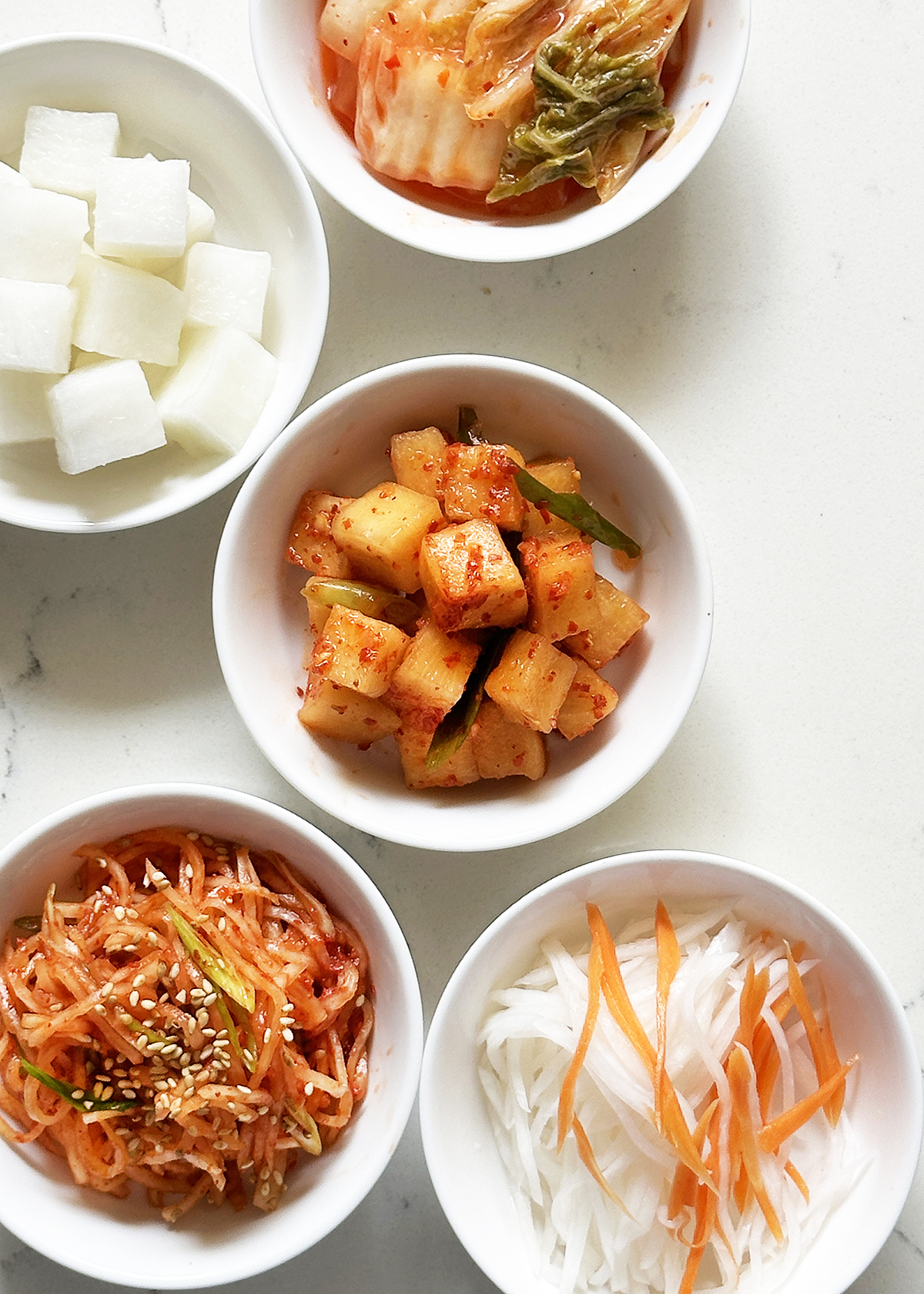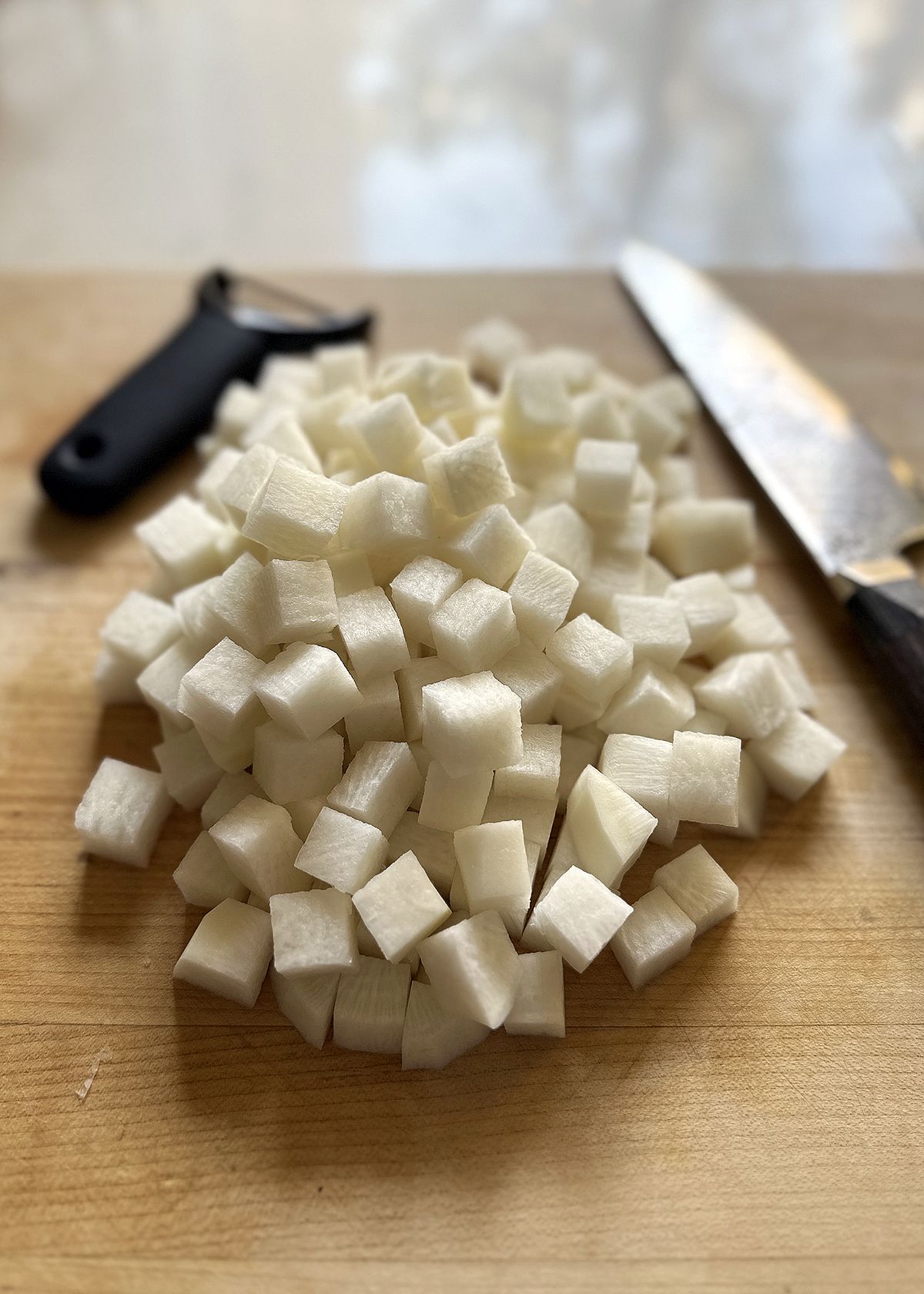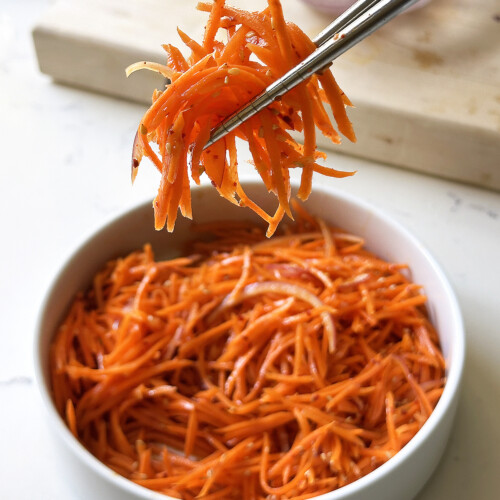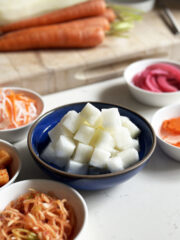Korean Pickled Radish is so easy to make, it's going to become a go-to recipe because it only requires 4 ingredients and is endlessly forgiving and flexible. And it goes without saying it's crisp, refreshing, and totally delicious. Shall we?

Jump to:
- So What is Korean Pickled Radish aka "Chicken Mu?"
- Chicken Mu vs Mu-Saeng-chae Kkakdugi vs vs Mu Namul...Korean Radish Banchans
- Is Korean Pickled Radish/Chicken Mu Healthy?
- What Ingredients You Need for Korean Pickled Radish/Chicken Mu
- What's the Best Radish for Korean Pickled Radish/Chicken Mu?
- How to Make Korean Pickled Radish/Chicken Mu
- Pro Tips, Tricks, and Technique FAQs
- Best Vegetables to Pickle
- Korean Pickled Radish Recipe
So What is Korean Pickled Radish aka "Chicken Mu?"
If you've sat down for Korean Fried Chicken and couldn't stop eating the crunchy little cubes of white radish that come alongside, I don't blame you. Korean Pickled Radish, known as "Chicken Mu" is a must-have at every meal because it's so good and so refreshing.

Chicken Mu vs Mu-Saeng-chae Kkakdugi vs vs Mu Namul...Korean Radish Banchans
All of these dishes are made from crisp, refreshing Korean radish and served as little side dishes known as banchan. However, Pickled Korean Radish aka Chicken Mu, kkakdugi, mu-saeng-chae, and mu namul are all distinct from one another in the way the radishes are cut, prepped, and seasoned.
Chicken Mu 치킨무 is a type of vinegar pickled radish made from Korean radish that is cut into small cubes and pickled directly in a vinegar brine. Chicken Mu gets its name because it almost always accompanies Korean Fried Chicken!
Mu-saeng-chae 무생채 is also a type of vinegar pickled radish, but unlike Chicken Mu, this version is made from julienned Korean radish that is seasoned with salt, sugar, and sometimes a little bit of red pepper. Since it's not fermented, you can also call it a salad. I LOVE this and used to buy giant pre-packed plastic containers of it from the Korean grocery store and just eat it straight from the container.
Kkakdugi 깍두기 is a type of radish kimchi, seasoned with spices and then fermented, which gives it its natural tartness. Korean radishes are almost always cut into small cubes similar to Chicken Mu, but spicy and fermented. There are a few different types of kimchi made from different radishes; kkakdugi is this one shaped like cubes!
Mu Namul 무나물 is the only one of these Korean radish dishes that isn't pickled or fermented. It is radish julienne that is sautéed with garlic and sesame. Mu namul is one of the vegetables on everyone's favorite Korean dish, Bibimbap.
Is Korean Pickled Radish/Chicken Mu Healthy?
Depending on your health needs and dietary considerations, Korean Pickled Radish/Chicken Mu can be healthy! To be honest, I can't really think of a case in which it would not be healthy, unless maybe spice or acid from the fermentation process causes heartburn or other gastric issue for you.
Though they are a root vegetables, Korean radishes are considered non-starchy vegetables so they are appropriate for low-sugar/low-carb lifestyles. And did you know that radishes are part of the Brassica family, the same family as broccoli, brussels sprouts, cauliflower and kale!
Radishes provide vitamin C, which along with a few other compunds, give radishes anti-cancer and anti-diabetes properties. Studies have shown that radishes also support healthy liver function and can improve cardiovascular health.
Health and Dietary Considerations of Korean Pickled Radish/Chicken Mu
As published, this recipe for Korean Radish Kimchi is:
- 100% plant-based, suitable for vegans
- vegetarian
- dairy-free
- gluten-free
- wheat-free
- grain-free
This recipe is keto-, Whole30-, and low-carb adaptable with non-nutritive sugar substitutes.

What Ingredients You Need for Korean Pickled Radish/Chicken Mu
Korean Pickled Radish/Chicken Mu fresh/refrigerator ingredients:
- Korean radish, aka "mu"
Korean Pickled Radish/Chicken Mu dry/pantry ingredients:
- rice vinegar
- sugar
- salt

What's the Best Radish for Korean Pickled Radish/Chicken Mu?
The recipe is called "Korean Pickled Radish" not only because it's a Korean dish, but because the radish itself is a Korean variety. Korean radish is called "mu" or "moo." It looks like a shorter, wider Japanese daikon radish with pale green skin at the neck and shoulders. It is slightly more dense than other radishes, and a more pronounced flavor, though radishes tend to have a mild flavor in general. Because the seasonings, spices, and fermentation in the final kimchi are very strong, Korean radish can stand up to them! I buy Korean radish at whatever Asian grocery store happens to be on my shopping route at the time.
The longer, narrower Japanese daikon radish is a near-exact substitute for Korean radish. Daikon radishes are generally more available in regular grocery stores where I live, Los Angeles. The biggest difference is that you will not cut as many perfect cubes from Japanese daikon radish because it's smaller!
Additional Ingredients Notes and Resources
Rice Vinegar. I use this brand organic brown rice vinegar. If you don't have rice vinegar, use any other light/mild vinegar like apple cider vinegar or white wine vinegar.
Any other fresh herbs and produce from either the Santa Monica Farmers' Market on Wednesday, Mar Vista Farmers Market on Sunday, or Whole Foods Market when I can't find what I need at the farmers' market.
How to Make Korean Pickled Radish/Chicken Mu

If you haven't already, peel Korean radish, carve out any little bruises or divots and cut into ¾-inch cubes.

Place radish cubes in large glass jar or container with tight fitting lid.

Stir together rice vinegar, sugar, salt, and ½ cup hot water until sugar and salt dissolve.

Pour vinegar brine over radish cubes. There should be enough brine to completely cover the radishes, but if it's shy by a few tablespoons, top off with plain water.
Allow the radishes to pickle for at least 2 hours before serving/eating. After 2 hours, the Korean Pickled Radish will taste lightly pickled. After 1 day, it will taste even better. Korean Pickled Radishes taste better and better each day.

Pro Tips, Tricks, and Technique FAQs
- Quart-size mason jar fits this recipe. A quart-sized mason jar (32 ounces) is the exact size for this recipe, or two pint-size jars. If you use the smaller jars, get the wide mouth version because they are easier to fill AND the lids are the same size as the quart so you don't have to try and keep track of matching lids.
- Save your kimchi jars! If you buy kimchi in glass jars, wash and save the larger jars once you finish the kimchi and MAKE A VOW to yourself that you will indeed use them for making your own pickles and kimchi and not just let the empty jar sit at the back of your storage drawer with all the other random odd sized jars and plastic tubs you've hoarded through the last 10 years. Yup, there, I said it.
- If this is your first time making Korean Pickled Radish/Chicken Mu, make this recipe exactly as is so you can get a feel for the technique and what you like in terms of flavor. I have always found restaurant versions of Chicken Mu a little too sweet, so this recipe has less sugar and more vinegar!
Tools and Equipment
As I say for just about any recipe, there isn't any special tool or piece of equipment required to make this Korean Pickled Radish/Chicken Mu. You can make it using a sharp chef's knife on a sturdy cutting board to cut the radish! However, that isn't to say there are a few tools that might make it slightly easier to get the Korean Pickled Radish/Chicken Mu from the farmers market to your fork (or chopsticks)!
- Chef's knife, my personal workhorse
- Wooden cutting board, oversized for all those radish cubes
- Vegetable peeler once I switched to this from the old-school swivel style, I never looked back
- Glass mixing bowls
- Mini ¼-cup liquid measuring cup
- Glass storage containers with airtight lids
- Quart Glass mason Jars
- Glass 1-pint mason jars, wide mouth because they're easier to use and wash
- Mason jar lids that are better than those horrible 2-piece metal lids, these fit all jars labeled "wide-mouth"
How Far in Advance Should You Make Pickled Vegetables?
Korean Pickled Radish/Chicken Mu is best when made at least a few hours in advance, after which it will be lightly pickled.
Even better is two or three days in advance, it will taste like the Korean Pickled Radish/Chicken Mu you know and love. The longer you let Korean Pickled Radish/Chicken Mu chill out in your refrigerator, the more it will pickle into its tangy, funky glory.
Technically, you can make and eat Korean Pickled Radish/Chicken Mu right away; it will just taste like a fresh, crunchy radish salad.
How to Store Prepped or Leftover Korean Pickled Radish/Chicken Mu
Refrigerator. You can keep Korean Pickled Radish/Chicken Mu in a tightly sealed container in the refrigerator for two weeks as long as you use clean utensils every time you remove some of the Korean Pickled Radish/Chicken Mu from the jar. Technically, pickles can last for weeks because that is the point of pickling, but 1) you will probably finish eating a quart-sized jar in a matter of days, and 2) the "weeks" assumes you don't open the jar and use your own dirty chopsticks to tke two bites out every few hours.
Freezer. Korean Pickled Radish/Chicken Mu does not freeze well. Just let it pickle in the refrigerator.
Ingredients Substitutions and FAQs
The recipe for this Korean Pickled Radish/Chicken Mu is considered "fool-proof" because it is very forgiving in terms of ingredients, measurement precision, and technique, i.e. it is not "canning" and there is no watchfulness required, just a day on the countertop to lightly ferment before moving to the refrigerator. Here are the pro-tips:
- Different Radish? If you do not have access to Korean radish aka "mu," or "moo," you can substitute in Japanese daikon radish or even turnips! If you only have smaller round radishes, you can definitely use the same seasoning ingredients, and the final dish will have a similar vibe, but it will be you know, different. To be honest, the brine recipe is a pretty univeral ALL-PURPOSE vinegar brine, and you can use it on just about any vegetable.
- Different Vinegar? If you don't have rice vinegar, you can also use apple cider vinegar, which will add just the slightest tinge of color as well as a fruity vibe. You can also use distilled white vinegar, though it has a sharper bite so you might need to add a little more sugar.
- Sugar Substitute? Rather than substituting in a non-nutritive sugar substitute, I generally just reduce the amount of sugar when needed. However, you can substitute in a non-nutritive, natural sweetener like stevia or monkfruit.
What to Serve with Korean Pickled Radish/Chicken Mu
Oh, you mean you can't just eat Korean Pickled Radish/Chicken Mu straight out of the jar with a pair of chopsticks standing over the kitchen sink and call that dinner?
Not that I've done that.
Not that I've not done that either.
Korean Pickled Radish/Chicken Mu is considered an accompanying side dish, "banchan," usually with a few other little pickley, ferment-y vegetables on the table. When the main event is the obvious Korean Fried Chicken or a heartier dish like Galbi Jjim, the crispy crunchy texture of Korean Pickled Radish/Chicken Mu is the perfect counterbalance.
Pile Korean Pickled Radish/Chicken Mu over a bowl of fluffy steamed rice along with some of the tart pickling liquid from the jar and now THAT you can call a dead-easy weeknight dinner. If you really want to get fancy, move it from the kitchen sink to the table and add any of the little dishes in the next section!

Best Vegetables to Pickle
These are the best things to pickle with a vinegary, sometimes citrus-y brine:
- Perfect Pickled Onions
- Salsa Criolla, Peruvian Spicy Lime-Pickled Onions
- Vietnamese Pickled Carrots and Daikon Radish, aka Do Chua
- Garlicky Soy Sauce Pickled Vegetables
If you want to add some spice to that sour, try these:
- Spicy Korean Cucumbers, Oi Muchim
- Spicy Pickled Radish Salad, aka Mu-Saeng-Chae
- Korean Radish Kimchi aka Kkakdugi
- Spicy Korean Carrot Salad, not technically pickled, but super tart from vinegar!
Korean Pickled Radish Recipe
Ingredients
- 1 pound Korean radish “mu” about 1 medium radish
- ¼ cup rice vinegar
- 3 tablespoons sugar
- 1 tablespoon sea salt
Instructions
- Peel and dice radish into ½-inch cubes.
- Pack radish cubes into a 32-ounce glass jar or container with an air-tight lid.
- Stir together rice vinegar, sugar, salt, and ½ cup hot water until sugar and salt dissolve.
- Pour vinegar brine over radish cubes. There should be enough brine to completely cover the radishes, but if it's shy by a few tablespoons, top off with plain water.
- Keep Pickled Radish in refrigerator.













JC says
love these pickles and love this photo!
Simon says
Being in australia its impossible for me to try these pickles (which is a shame as they look delicious!)
As to your question about pickles being a side dish or a condiment. In my mind they fall one hnudred percent in the side dish category. If you try adding pickles to anything then all you can taste is pickles!
Simon says
Being in australia its impossible for me to try these pickles (which is a shame as they look delicious!)
As to your question about pickles being a side dish or a condiment. In my mind they fall one hnudred percent in the side dish category. If you try adding pickles to anything then all you can taste is pickles!
Simon says
Being in australia its impossible for me to try these pickles (which is a shame as they look delicious!)
As to your question about pickles being a side dish or a condiment. In my mind they fall one hnudred percent in the side dish category. If you try adding pickles to anything then all you can taste is pickles!
Simon says
Being in australia its impossible for me to try these pickles (which is a shame as they look delicious!)
As to your question about pickles being a side dish or a condiment. In my mind they fall one hnudred percent in the side dish category. If you try adding pickles to anything then all you can taste is pickles!
Simon says
Being in australia its impossible for me to try these pickles (which is a shame as they look delicious!)
As to your question about pickles being a side dish or a condiment. In my mind they fall one hnudred percent in the side dish category. If you try adding pickles to anything then all you can taste is pickles!
Simon says
Being in australia its impossible for me to try these pickles (which is a shame as they look delicious!)
As to your question about pickles being a side dish or a condiment. In my mind they fall one hnudred percent in the side dish category. If you try adding pickles to anything then all you can taste is pickles!
Simon says
Being in australia its impossible for me to try these pickles (which is a shame as they look delicious!)
As to your question about pickles being a side dish or a condiment. In my mind they fall one hnudred percent in the side dish category. If you try adding pickles to anything then all you can taste is pickles!
Simon says
Being in australia its impossible for me to try these pickles (which is a shame as they look delicious!)
As to your question about pickles being a side dish or a condiment. In my mind they fall one hnudred percent in the side dish category. If you try adding pickles to anything then all you can taste is pickles!
Jana @ 333 Days of..... says
Love those pickles too!!! Do you have the recipe?